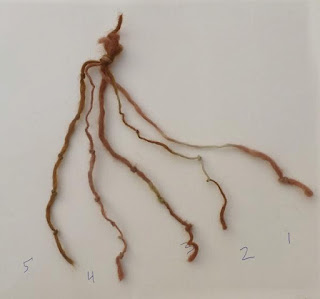(click pictures on blog for larger image)
For March, the Saturday Group of Sacramento Weavers and Spinners Guild met at the home of member Cathy Sweeney for a dye session.
Here is Sue, Connie, Linda and Sara are tying up some samples of wool yarn that has been pre-treated with different mordants. Five knots is tin. Four knots is iron. Three knots is copper. Two knots is chrome. One knot is untreated. They will be put into the dye pots so we can see how the mordants react differently in the same dye.
EDITED TO ADD: Here is a mordant test bundle I brought home. There is a difference in color with the same dye, different mordant chemicals. From left to right: Tin, Iron, Copper, Chrome, Untreated.
Goldfinches visit one of the bird feeders.
The pots are set and we wait for the water to heat up. Notice the empty rack on the left. That will become a very busy piece of equipment.
One of pots has California Native Black Walnut husk, another has Silver Dollar Eucalyptus, another pot has Oak Galls from Valley Oak trees,
We had a pot of Red Onion skins and another pot of Marigold flowers (not shown).

Cathy has a lot of reference books, she has mordants, she has propane stoves, and most importantly, she has gloves to prevent your hands from turning colors.

Cathy also keeps a scrapbook that has index cards with snips of yarn samples from dying so she can repeat a process when a certain color is desired. We loaded up the pots with our yarn samples and let them set.
While waiting for the pots to set the color on our yarns we waited. We chatted about projects we are working on and are planning. And I enjoyed looking at the flowers. I need some of these to plant next to the condo.

We also played with Kool-Aid softdrink mix powder and liquid food colors in mason jars. Koolaid is a popular dye that is inexpensive and non-toxic.

Here is the result of Strawberry Koolaid and Cherry Koolaid as dye. Notice how pale the liquid is now that the color has been drawn into the yarn. That is called "exhausting" the dye.

This Cooper's Hawk is a local resident and kept flying over the area.

Cathy shows off a purse that she knitted then over-dyed with Madder root which is a strong red dye. She says the upper part of the bag was light green like the yarn in the handle but the Madder changed it to this dark brick color.

Cathy pulls up the yarn that was sitting in the jars with koolaid, making a multi-colored skein.
Here I am with Stephanie fishing out a skein from the pot of marigold flowers.
It was a beautiful day. Overhead there is a flight of Sandhill Cranes, big birds with big booming calls.
Here we have yarns drying on the rack. Most of them went into the natural dye pots, with a few colored with koolaid.
This is my little set of five samples. I used bright white cotton yarn. From left to right, Onion, Eucalyptus, Black Walnut, Oak Galls, Marigolds. They will be washed later. I plan to weave them into a sampler for display.
EDITED TO ADD: This is my little set of samples after washing in cold water. From left to right, Onion, Eucalyptus, Black Walnut, Oak Galls,
Marigolds, Indigo, and the mordant test bundle.
Loading up the rack with so much! I'm surprised it did not collapse!
With the natural dyes all done, Cathy started a pot of Indigo dye, which is a very strong blue dye. Here is Nancy in the straw hat, Sue in the red apron, and our youngest Saturday Guild member, Ellie, is winding yarn on a niddy noddy for a skein to dip into the indigo.
This is the pot of indigo. In a process not well understood by me, the oxygen is displaced from the liquid before dipping the yarn in for dying. Care has to be taken not to stir, or drop yarn too quickly so as not to introduce air bubbles into the liquid.
As we waited for things to drip dry the birds provided lots of entertainment. Here is a crow chasing a hawk.
Here are some of the items that were dipped into the indigo dye. The color develops as the yarn is exposed to air after dipping. Some of the yarns are dipped more than once. The bottom left is raw wool that was dyed in mesh bags. The skein to the left center of the picture with the purple and blue color is the skein that was koolaid dyed with red yellow and blue. Cathy overdyed it with the indigo!
Here is one members bundle of skeins. Sorry about the funny lighting but it was a nice bunch of yarns.
Not shown was the lunch which was pot luck with everybody bringing something. We had thirteen people in attendance with a couple of guests and new members.
Our next Saturday meeting will be
April 14 (Sat), 10 am - 12:30 pm At the Arcade Library
Spinning! Bring your spinning to show off!
Visit the Sacramento Weavers and Spinners Guild website for schedules
http://www.sacweavespin.org/saturday
I want to thank Cathy Sweeny for a wonderful time playing with dyes. One of the best things about being with the Guild are the members who are willing to share their knowledge and experience.
It was a good day!














































